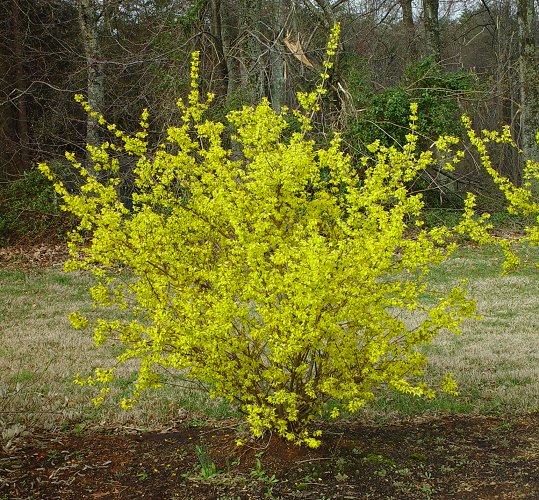Forsythia suspensa (Thunb.) Vahl
Weeping Forsythia

Introduced
CC = *
CW = 5
MOC = 4
© DETenaglia
Forsythia suspensa (Thunb.) VahlWeeping Forsythia | |
 |
Introduced CC = * CW = 5 MOC = 4 |
© DETenaglia |
|
Family - Oleaceae Habit - Perennial shrub, to 3 m tall. Stems - Numerous from base, erect to arching, sometimes rooting at the tips, the bark tan, thin, the outer layer usually peeling in thin strips with age. Twigs stout, green to reddish brown, becoming yellowish brown, glabrous, more or less 4-angled in cross-section, at least when young, with raised leaf scars and warty, oval, pale lenticels. Terminal buds ovoid to ellipsoid, with several, overlapping, sharply pointed scales, the axillary buds broadly ovoid, with scales that are pointed at the tips.
Leaves - Opposite, petiolate. Petioles to 1.5 cm, glabrous. Blades simple and at least in a few leaves ternately lobed and/or compound, 2-10 cm long, 1.5-5.0 cm wide, the blade or leaflets broadly ovate (in lobed leaves) to ovate or oblong-ovate, angled or tapered to the usually sharply pointed tip, rounded or angled at the base, the margins irregularly and sharply toothed, the surfaces medium green to yellowish green and glabrous.
Inflorescence - Axillary, of solitary flowers or more commonly small clusters of 2 or 3 flowers, produced from near the branch tip to older portions of branches, developing before the leaves, but often persisting as the leaves begin to expand; bracts absent, the flowers with slender stalks 3-6 mm long, not or only slightly fragrant.
Flowers - Perfect. Calyces deeply 4-lobed, 4-7 mm long, the lobes oblong. Corollas deeply 4-lobed, 15-25 mm long, bell-shaped to more or less saucer shaped, the lobes narrowly oblong to strap-shaped, yellow, glabrous, the 4-5 mm long tube often with orange stripes along the inner surface. Stamens 2, fused to base of corolla tube. Style 1-2 mm long, with a pair of ascending branches at the tip.
Fruits - Fruits very rare in North American plants, 2-locular, longitudinally dehiscent capsules, 15-25 mm long, narrowly ellipsoid to narrowly ovoid, beaked, brown with scattered, pale lenticels (seeds numerous, minute, narrowly winged). Flowering - March - April. Habitat - Cultivated. Origin - Native to Asia. Lookalikes - Other species of Forsythia. Other info. - Forsythia is one of the first plants to bloom in Missouri in the spring. The brilliant yellow flowers are impossible to miss, brightening the spring landscape. The flowers appear before the leaves but typically remain until the plant is almost leafed out. There are other species of Forsythia which are cultivated in Missouri but nearly all look alike. They can (sometimes) be differentiated by looking at the hairiness of the leaves and the pith (or lack of) of the twigs and branches. Photographs taken off Hwy 66, Stokes County, NC., 3-22-03 (DETenaglia); also in Washington, Franklin County, MO, 4-12-2019, and Weldon Spring Conservation Area, St. Charles County, MO, 3-30-2020 (SRTurner). |